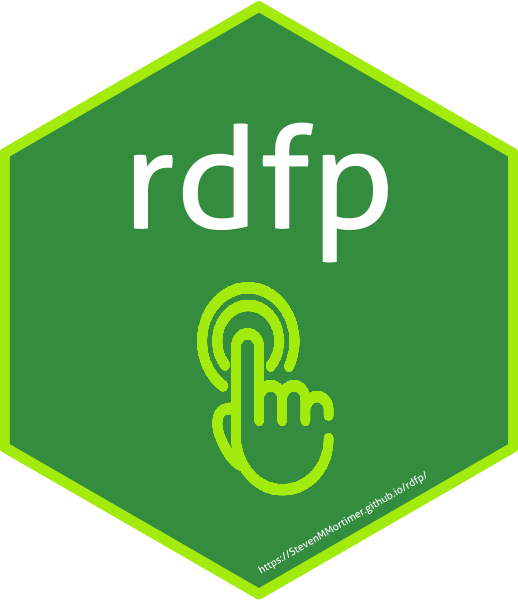
Compiled using DFP API version: v201905
rdfp allows you to use the DoubleClick for Publishers API from R (recently renamed to Google Ad Manager). Manage inventory, create orders, pull reports, and more!
Installation
# install from CRAN
install.packages("rdfp")
# or get the latest version available on GitHub using the devtools package
# install.packages("devtools")
devtools::install_github("StevenMMortimer/rdfp")If you encounter a clear bug, please file a minimal reproducible example on GitHub.
Vignettes
The README below outlines the package functionality, but review the vignettes for more detailed examples on usage.
Usage
All functions start with dfp_ so that you can easily identify DFP-specific operations and use tab completion in RStudio. Most rdfp functions will return a tbl_df or list parsed from the XML returned in the SOAP response.
Load Package and Set API Version
Google releases 4 versions of the DFP API each year and deprecates versions older than one year, so there is a lot that’s regularly changing in this package. rdfp is periodically compiled against a recent version of the API. If you would like to use an older or newer API version that what is the package default, then just specify it as an option.
Authenticate
To authenticate you will first need to specify the network_code of the DFP instance you would like to connect to. This is the only required option that the user must specify when using the rdfp package. After setting the network_code all you need to do is run dfp_auth(). If you already have a cached .httr-oauth-rdfp file in the current working directory, then the token will be loaded and refreshed if necessary. Otherwise, your browswer will pop open and you will interactively authenticate.
The package has other options like a client_id and client_secret where you can connect using your own Google Client instead of the package default. Using your own client requires you to first set one up in the Google Developers Console.
options(rdfp.network_code = "12345678")
options(rdfp.application_name = "MyApp")
options(rdfp.client_id = "012345678901-99thisisatest99.apps.googleusercontent.com")
options(rdfp.client_secret = "Th1s1sMyC1ientS3cr3t")
# dfp_auth will use the options above and cache an OAuth token in the working directory
# the token will be refreshed when necessary
dfp_auth()Get Current User Info
# Check current user or network
user_info <- dfp_getCurrentUser()
user_info[,c('id', 'isActive')]
#> # A tibble: 1 x 2
#> id isActive
#> <dbl> <lgl>
#> 1 185549536 TRUE
network_info <- dfp_getCurrentNetwork()
network_info[,c('id', 'networkCode')]
#> # A tibble: 1 x 2
#> id networkCode
#> <dbl> <dbl>
#> 1 109096 1019096Pull a LineItem
The function dfp_getLineItemsByStatement() function from the LineItemService allows you to retrieve Line Items by Publishers Query Language (PQL) statement. The statement is constructed as a list of lists that are nested to emulate the hierarchy of the XML that needs to be created in the request.
# Retrieve up to 3 Line Items that have a status of "DELIVERING"
request_data <- list('filterStatement'=list('query'="WHERE status='DELIVERING' LIMIT 3"))
resultset <- dfp_getLineItemsByStatement(request_data, as_df=TRUE)
resultset[,c('orderId', 'id', 'priority', 'deliveryRateType')]
#> # A tibble: 3 x 4
#> orderId id priority deliveryRateType
#> <dbl> <dbl> <dbl> <chr>
#> 1 2231707164 4557799162 12 EVENLY
#> 2 2231707164 4557800341 12 EVENLY
#> 3 2231707164 4557803758 12 EVENLYRun a Report
Below is an example of how to make a simple report request.
# In order to run a report you must specify how the report should be structured
# by specifying a reportQuery inside a reportJob. All of the dimensions, columns,
# date range options, etc. are documented at:
# https://developers.google.com/ad-manager/api/reference/v201905/ReportService.ReportQuery
request_data <- list(reportJob=list(reportQuery=list(dimensions='MONTH_AND_YEAR',
dimensions='AD_UNIT_ID',
adUnitView='FLAT',
columns = 'AD_SERVER_IMPRESSIONS',
columns = 'AD_SERVER_CLICKS',
dateRangeType='LAST_WEEK'
)))
# a convenience function has been provided to you to manage the report process workflow
# if you would like more control, see the example below which moves through each step in the process
report_data <- dfp_full_report_wrapper(request_data)
report_data[,c('Dimension.MONTH_AND_YEAR', 'Dimension.AD_UNIT_ID', 'Column.AD_SERVER_CLICKS')]
#> # A tibble: 18 x 3
#> Dimension.MONTH_AND_YEAR Dimension.AD_UNIT_ID Column.AD_SERVER_CLICKS
#> <chr> <dbl> <dbl>
#> 1 2019-05 21677451947 936
#> 2 2019-05 21677451950 173
#> 3 2019-05 21677553898 5447
#> 4 2019-05 21677553901 102
#> 5 2019-05 21677553904 4304
#> 6 2019-05 21677451953 2264
#> 7 2019-05 21677553910 44
#> 8 2019-05 21677553913 2637
#> 9 2019-05 21677554012 69
#> 10 2019-06 21677451947 431
#> 11 2019-06 21677451950 66
#> 12 2019-06 21677553898 1740
#> 13 2019-06 21677553901 43
#> 14 2019-06 21677553904 1895
#> 15 2019-06 21677451953 865
#> 16 2019-06 21677553910 20
#> 17 2019-06 21677553913 1146
#> 18 2019-06 21677554012 34Credits
This application uses other open source software components. The authentication components are mostly verbatim copies of the routines established in the googlesheets package (https://github.com/jennybc/googlesheets). We acknowledge and are grateful to these developers for their contributions to open source.
More Information
Google provides support for client libraries here, but unfortunately, R is not a supported language. Google’s client libraries directly reference the production WSDLs to interact with the API, but this package makes SOAP requests best formatted to match the WSDL standards. This articulation is not perfect and continued progress will be made to bring functionality up to par with the client libraries.
Most all operations supported by the DFP API are available via this package. It is strongly recommended that you use the DFP API Reference when using this package. Details on formatting, attributes, and methods are all better explained by Google’s documentation.